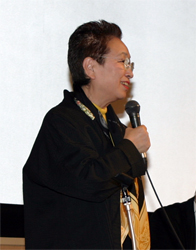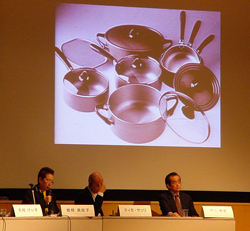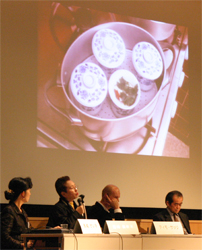|
|

|
Presentation
|

|
-
Beyond Times - Quietness in our life
Masako Sone
Product Design
Prof. University of Art and Design Helsinki
 *Seeking the wholeness of tools *Seeking the wholeness of tools
It might make our discussion useless if we just try to directly connect quietness and aspect of sound. Only design practice relating sound will lead us to think.
Here I would like to extend the objective of the discussion on "designing the quietness" from a sound, one of the human five senses can detect, to the wholeness of human five senses. Since I have been a professional product designer, designing a tool for our hand use so to speak, I would like to talk about the design in the resonance between the wholeness of tools themselves and human sensibility.
Sound is placed at the opposite side of quietness, to be sure. Although I am afraid about losing focus of the discussion if we tried to talk about wholeness with the subject of Quietness by omitting relation between tools and sound, I believe that the discussion not omitting the relation will contrary lead us to the essence of the discussion.
Because the structure of Chinese character for "Quietness" delineates the state of wholeness of tools. (theory of Shizuka Shirakawa) Each element consisting the character is derived from an agricultural tool such as a spade, and it also means the tool used for cleaning a sacred ritual place for praying and offering to agricultural deities. So that the place should be clean and quiet where the tool serves quietness. Therefore I can assert that the ultimate objective of tools should be "Quietness."
The "Quietness" represents the essential posture of tools. Nevertheless, contrary to the essence, tools existing in our times wear a myriad of added value and very talkative and noisy. It was very big issue that how I can design a tool as a quiet existence.
Now I will introduce here to you one of my design works with such a theme done ten years ago when I used to work for GK Institute of Dougu.
*Designing Pots and Pans
The work was born in the following situation.
While I was observing kitchens, which meant the "site of eating," for several years, I found that something wrong with pots and pans. Pots and pans were confusing kitchens. To say nothing of the cooking counter, pots and pans settled down everywhere ranging from the shelves to the refrigerator. When the sink cabinet doors were opened, those pots and pans were piled up high on each other in it and the one underneath the pile could hardly be pulled out. I even noticed a case that people complained that the wares were not easy to use because pulling them out of the pile was troublesome. In the survey of the number of those wares in households, more than 75% of surveyed had 21 or more and even some households owned 50~60. By being asked how many pots and pans were actually used, over 75% of surveyed responded as roughly 5 pots and pans would be good enough.
In such a paradoxical and chaotic situation of wares used in confusion, many of them were actually cheap looking and almost stopgap products. Also many other kinds of pots and pans selected from rich options, ranging from the ones boasting various additional functions and high performance, designers brands and foreign made pasta pans, to the ones decorated with flower patterns, are occupying the kitchen. However, they had advantage and disadvantage for daily heavy use and in the end less attractive cheap pots and pans were used as a matter of fact. If these daily use wares are replaced by decent set of wares, in necessary enough number and kinds, easy use, beautiful, easy to store, worth making good kitchen-scape, far better culinary life with delicious food can be realized. Thus all junk like pots and pans can be discarded then followed by re-emergence of pacific kitchen-scape.
 While we were discussing such situation, a magazine "Croissant" asked us "What is current most problematic utensils?" and I answered "That's pots and pans" with no hesitation. While we were discussing such situation, a magazine "Croissant" asked us "What is current most problematic utensils?" and I answered "That's pots and pans" with no hesitation.
Croissant was a magazine subscribed widely by housewives with its editorial policy in provoking their true concern in their daily life. The magazine was also operating "Croissant Shop" selling products it selected and producing an original product to sell. Therefore the magazine was defined as a social information oriented medium.
Both parties, Croissant and we, together went through current visual data of pots and pans which seemed to be even not worth questioning about design, and shared a same spirit to tackle the problem in cooperation by developing a necessary enough and essential set of wares.
The parties first looked into the data consisting of survey done by GK Institute of Dougu and tremendous volume of questionnaires done by Croissant through its magazine operation, and then agreed on a mutual design concept and a formative expression policy in which "should be" and essential shape of pots and pans were determined first.
After that, a manufacturer who would produce the wares was sought. Luckily we found a manufacturer, who was very capable of technological development and manufacturing quality products, offered to manufacture the wares. By overcoming many problems on manufacturing, the post and pans we wanted were materialized. The wares became overwhelming market hit as many retailers in general including department stores awaited the products with their shelves exclusively open for the wares. For more than ten years, the wares have played very well in the market and kitchens since then.
I believe thus we could materialize quiet wares beyond times through "ordinary pots and pans." So what did it make successful?
* Started contemplating reality in daily life, and perceived "ordinary pots and pans." --- Aimed at long lasting wares in kitchens, not wining products in shop fronts, away from differentiating from many competitive products.
* To value daily cooking --- though there are a variety of distinctive cooking features, persisted with principal Japanese style cooking (boiling and taking broth). By defying on going trend of skipping cooking process such as eat out and using retort food,
re-emergence of good taste from home cooking was hoped, and wanted to have a whole piece of food materials boiled and steamed that have been disappearing from day to day home cooking.
 * Honest and humble design as wares --- various additional functions, ornaments and coloring were utterly left out, and tried to create formative expressions mirroring their principal functions to attract users' intention to get them tried. * Honest and humble design as wares --- various additional functions, ornaments and coloring were utterly left out, and tried to create formative expressions mirroring their principal functions to attract users' intention to get them tried.
* Without any commissioning client, autonomous design development took place first and then a manufacturer was sought. --- the project started without commissioned by any client, it was entirely conducted by designer's independent control .Usually, however a design is excellent, a client's decision overrules the fate of the design.
* Made use of media effect --- by putting importance on subscribers "/readers" views on things, the articles ranging from product development process to what the product meant to daily life were edited.
* Long period of developments --- We didn't compromise any process of producing products in such as research, planning, design development, engineering, manufacturing and merchandising in spending four years. No labor was spared, perceived and proved every relevant aspects and tried to carry out productユs longer life in the market.
For the last 12 years since the wares were marketed, the wares have experienced curious history to be manufactured. A fist manufacturer, Toshin Press, became bankrupt amid economic slow down. However, Sankyo Aluminum succeeded the manufacturing right away. Regretfully the company withdrew from cooking ware manufacturing. And then the production was succeeded by "Japan Meyer."
Beyond Times
Tools serving our various daily behavior or producing more decent life through users' manner should represent a form and a shape that firmly serve the essential purpose of users, in which I believe we can find the style of "Quietness."
Almost all tools in industrialized societies are manufactured to be sold as merchandise. In the course of the tools are sold, which facilitates our life, they become merchandise. Merchandise turns into tools in its use and process of serving us.
To its aspects of the merchandise, the atmosphere of times and trend supporting the merchandise such as fashion, brand, image as marketing strategy are added. Functions so called value are often fully added to products quite explicitly and they are often decorated with all sorts of flowery formative words. They are deemed as a big noisy group of tools. The market being made up of such trend and atmosphere is in a state of ferment with big noise created by very talkative tools. And then, while the tools settled in our day to day life with value of times failed to become straight and ordinary tools, they are beaten by next generation of merchandise, discarded, forgotten with no use and building clumsy and noisy-scape.
The Quiet Design
I assume that it might be a healthy design ethic beyond times that is to create a tool with decent and primary function. The tool should be the one with low profile, ordinary, stable posture, and with which users can perform well according to their own technique level amid self claiming and appealing noise of other tools.
A healthy and humble tool is tend to be taken as the one that will be left behind by trend, ignored, less marketable and won't sell as if it is blind to trend of times.
However, manufacturing of the products I have introduced here have been consistently succeeded one after another. The reason is of course the products have kept selling well to date. This phenomenon proved that people live our times never have lost their sensibility. I believe that the people are now reclaiming their keen sensibility on tools.

Secretariat
Japan Finland Design Association (Japan)
c/o The Finnish Institute in Japan
3-5-39 Minami Azabu, Minato-ku, Tokyo, Japan 106-8561

c/o GK Graphics Incorporated
telephone : 03-5952-6831 facsimile : 03-5952-6832
e-mail : jfda@gk-design.co.jp
previous
|
|
